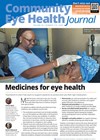In the third in our series about community eye care in the home nations, David O’Sullivan explains how Wales has developed its community eye care services.
Since the devolution of healthcare to Wales on 1 July 1999 [1], significant changes have developed in the provision of eye care services and the use of the optometric workforce in primary care.
Whilst the core General Ophthalmic Service (GOS) examinations have largely remained unaltered during this period, the Wales Eye Care Services have evolved as additional examinations provided by optometrists.

Deganwy, Wales, UK.
The development of Wales’ eye care services
Recognising the increasing gap between the demand for, and capacity to provide, specialist hospital eye care services, Wales took the decision to utilise the available skilled optometric workforce. The launch of the Wales Eye Care Initiative in May 2002 brought together the Primary Eye Care Acute Referral Scheme (PEARS) and an enhanced examination for groups at risk of developing eye disease, including:
- people with sight in only one eye
- people with a hearing impairment
- people who suffer from retinitis pigmentosa
- people whose family origins are Black African, Black Caribbean, Indian, Pakistani and Bangladeshi.
The PEARS scheme, which was developed as a pilot by optometric practices in the Vale of Glamorgan, enabled optometrists to become the first point of contact for acute eye conditions in primary care, allowing optometrists to manage a range of non sight-threatening conditions and alleviate pressures on general practitioners. Referral routes to the hospital eye service (HES) were simultaneously revised, with direct referral from optometrist to HES becoming standard across Wales.
The routine dilation of patients, use of a binocular indirect retinal examination, threshold visual field testing and Goldmann tonometry, formed the basis of the enhanced provision for at-risk groups, with an emphasis on early detection of eye disease and improved outcomes for patients, with services being provided free of charge through the NHS [2].
Eye care services continued to develop with the introduction of the Low Vision Service Wales in 2003. With increasing waiting times for low vision appointments in hospital eye clinics across the country, the service was launched with optometrists and dispensing opticians in primary care.
Through the service, practitioners determine if any low vision aids are available to help a person with reduced vision. This might include a variety of magnifiers and visual aids for both distance and near tasks, as well as non-visual aids such as angled lamps and typoscopes. They also use their specialist knowledge to refer to other professionals and services who provide additional help and support including: social services, voluntary organisations, the Hospital Eye Service for registration as Sight Impaired or Severely Sight Impaired, education services or employment services.
The patient’s appointment with the low vision practitioner usually lasts about an hour and is provided free of charge by the NHS and all low vision aids are available on loan, and free of charge.
Access is through a number of routes including self-referral, hospital eye care services, social services or other professionals. Patients qualify if they have a visual acuity of 6/12 or worse, and / or near acuity of N6 or worse (with a plus 4 dioptre reading addition) or significantly constricted visual fields.
Since the early days of the Welsh Eye Care Initiative, and in line with policy developments through the Welsh Government, eye health services have further evolved and developed into the Wales Eye Care Services (WECS) [3]. WECS now encompasses Eye Health Examination Wales (EHEW), Low Vision Service Wales (LVSW) and Diabetic Eye Screening Wales (DESW).
“Recognising the increasing gap between the demand for, and capacity to provide, specialist hospital eye care services, Wales took the decision to utilise the available skilled optometric workforce”
The important role that optometrists have to play in reducing the burden, both upon the GP primary care services and the HES, are recognised in the WECS developments. Building upon the initial services provided, EHEW now comprises three service elements. Band 1 examinations encompass the initial services provided under WECS as described above. Band 2 examinations allow for referral refinement of a number of conditions following a GOS or private examination. This includes glaucoma repeat measurements, dilated cataract refinement and counselling, and other clinical scenarios that would result in either further informing a referral to the HES or preventing a referral resulting in the patient being managed by the optometrist in primary care. Band 3 examinations allow optometrists to follow-up patients after initial acute presentations, and facilitates the HES to discharge patients for postoperative cataract assessment in primary care.
These enhanced services have ensured optometrists have become the gatekeepers to the HES, reducing demand for specialist services and improving the working relationships between ophthalmologists and optometrists.
Training to support primary eye care services
Optometrists and ophthalmic medical practitioners (OMPs) on the ophthalmic performers list in Wales provide all services within GOS.
In order to be able to provide both EHEW and LVSW services, optometrists or OMP wishing to offer the service, and the practice where the service will be operating from, must be EHEW registered with the NHS Shared Services Partnership (NHS SSP).
Once registered, accreditation is required for each individual wanting to offer the service. This involves distance learning and practical based assessments and is provided by the Wales Optometric Postgraduate Centre (WOPEC).
WOPEC is the first Postgraduate Education Centre for optometry in the world. It is accommodated within the School of Optometry and Vision Sciences at Cardiff University and its core role is in providing training and assessment for approximately 700 primary care optometrists providing the Wales Eye Care Service [4].
EHEW and LVSW practitioners re-accredit to continue to provide services through WOPEC on a three-yearly cycle. This is through a similar process of distance learning and contact days to ensure that service developments are communicated accurately, and knowledge, skills and competencies are maintained.
Policy developments
Healthcare policy developments have enabled many of the innovative changes to take place, and Wales remains the only UK nation to have an Eye Care Delivery Plan. The ‘Together for Health; Eye Care Delivery Plan for Wales’ [5] was first developed in 2013 and will conclude in 2020. The plan brings together the work of primary care, secondary care and social care with deliverable outcomes.
More recently, ‘A Healthier Wales: our Plan for Health and Social Care’ [6] has provided the policy direction for all health services in Wales, and the strategic direction towards an integrated and coordinated approach to eye care services is informed by this important policy document.
Building upon the principles of Prudent Healthcare [7], which have been at the centre for healthcare changes in Wales, ‘A Healthier Wales’ was produced in response to a ‘Parliamentary Review of the Long Term Future of Health and Social Care’. An international panel of experts, chaired by Dr Ruth Hussey, called for a “revolution from within”, to drive the changes needed in the health and social care system, so that it is able to meet the needs of current and future generations in Wales.
The key principles include:
- longer, healthier and happier lives
- a whole system approach to health and social care
- an equitable system which achieves equal health outcomes for all
- services which are seamless, delivered as close to home as possible
- people will only go to a general hospital when it is essential
- using technology to support high quality, sustainable services.
The future
The importance of eye healthcare has long been recognised by the Welsh Government and remains a high priority for delivery. The foundations laid over the previous 20 years have enhanced the working relationships of all professional groups in Wales, with further innovative services being developed through local health boards to enable co-management of patients between the HES and EHEW accredited optometrists.
Over the course of the Eye Care Delivery Plan for Wales, the Welsh Government has made significant investment to providing higher qualifications in glaucoma, medical retina and independent prescribing to optometrists in Wales. This investment has enabled the development of Ophthalmic Diagnostic and Treatment Centres (ODTCs), providing a shared care model of service for follow-up of stable glaucoma patients in the community. More recently, developments by Aneurin Bevan University Health Board have seen macular services moved into a primary care optometric practice with referral refinement of suspected wet AMD cases combined with intravitreal injection clinics in the same location [8].
Through the introduction of Health Education and Improvement Wales [9], further investment into upskilling the primary care workforce is planned to support the necessary relocation of services into primary care.
‘A Healthier Wales’ committed to nationally reform primary care contracts covering four professional areas: general medical services, pharmacy, dentistry and optometry. For the optometry profession, this means reforming the General Ophthalmic Service Regulations and the Wales Eye Care Service Legislative Directions.
As part of contract reform, and building on the progress made since the launch of the Eye Care Delivery Plan, the Welsh Government has begun to scope and review current primary eye care services and alignment to the other primary care contractor professions, with an emphasis on:
- access
- working at scale, including value-based healthcare, multi-agency cluster led planning and delivery
- quality improvement and prevention
- shift from secondary to primary care.
The future of eye care services is challenging across the UK, but there are exciting opportunities in Wales to evolve and provide high levels of care to our ophthalmic patients. We have come a long way since the development of the Welsh Eye Care Initiative in 2002, with an appetite from the Welsh Government and the profession to change and lead on eye care reform. The time and effort that the ophthalmic profession in Wales have given to enable these changes cannot be underestimated, and practitioners continue to work at a high level to provide an excellent level of care for the benefit of the patients in Wales.
References
1. Government of Wales Act (1998) London.
https://www.gov.uk/guidance/
devolution-settlement-wales
2. Sheen NJL, Fone D, Phillips CJ, et al. Evaluation of the Primary Eyecare Acute Referral Scheme (PEARS) and the Welsh Eye Health Examination (WEHE) (2018) Welsh Government.
http://www.wales.nhs.uk/sites3/
Documents/562/NickSheenEnglish.pdf
3. NHS Wales. Wales Eye Care Services, Wales.
http://www.eyecare.wales.nhs.uk/home
4. Wales Optometry Postgraduate Education Centre (WOPEC)
https://wopec.co.uk/
5. Welsh Government. Together for Health: Delivery Plan for Wales, 2013–2018 (2013) http://www.wales.nhs.uk/documents/
Eye-Health-Care-Delivery-Plan-Wales-e.pdf.
6. Welsh Government. A Healthier Wales: our Plan for Health and Social Care Gov.wales. (2019) https://gov.wales/sites/default/files/publications/2019-10/a-healthier-wales-action-plan.pdf.
7. Bevan commission Prudent Healthcare (2013)
http://www.bevancommission.org/
en/prudent-healthcare
8. Health in Wales. First of its kind specialist eye centre launches in Newport (2016)
http://www.wales.nhs.uk/news/42544.
9. Health Education and Improvement Wales (2020)
https://heiw.nhs.wales/
(All links last accessed March 2020)
COMMENTS ARE WELCOME








